In last article, I tried to explain why our current treatment paradigms might be flawed and why it is important to understand and embrace the principles enshrined in Ashtanga Hridayam. In this article I will briefly touch upon the Ayurvedic Concepts of Prakriti and Doshas, understand in detail how clinical trials are inaccurate instruments to confirm and validate any evidence for Ayurveda and explain how modern medical genetics provides authoritative evidences proving accuracy of Ayurveda.
(This is a very crude attempt from my end to read and interpret Ashtanga Hridayam, and explain it’s principles in treating diseases. I am a medical doctor training in Allopathy, and I am deeply passionate about human biology. I will be explaining Astanga Hridayam using layman’s language with a perspective of an allopathy practitioner.)
Table of Contents
Prakriti And Doshas
Ancient India, like many other places in the world, has been a birthplace of extremely advanced civilizations. Vedic culture refers to a culture whose practices are documented in a set of ancient books called the Vedas. The origins of Vedic culture are believed to date back to the early Indus Valley Civilization, which flourished between 3300 BC and 1300 BC in the northwestern region of the Indian subcontinent. The Vedas are a collection of hymns, prayers, and rituals that were orally transmitted from generation to generation and eventually written down in Sanskrit between 1500 BC and 500 BC.
The Vedas consist of four main texts: the Rigveda, the Yajurveda, the Samaveda, and the Atharvaveda. Ayurveda is an ancient system of medicine described in Atharvaveda. Ayurveda has been practiced in India for over 5,000 years. One of the central concepts in Ayurveda is the idea of Prakriti, which refers to an individual’s unique constitution. Prakriti of an individual is a function of that person’s unique genetic makeup and how those genes express in life. Understanding a person’s Prakriti is essential for effective diagnosis and treatment in Ayurveda.(1)
According to Ayurvedic principles, matter is thought to be composed of five Mahabhutas (basic elements) that have the properties of space (Akasha), air (Vayu), fire (Tejas), water (Jala) and earth (Prithivi). These combine to form three Doshas, known as Vata, Pitta and Kapha. The Doshas can be imagined as “energies” that govern various aspects of the human body. Vata is formed from the lighter elements with properties of space (Akasha) and air (Vayu). Pitta is formed from the elements with properties of fire (Tejas) and water (Jala). Kapha is formed from the heavier elements with properties of water (Jala) and earth (Prithvi). Vata predominantly regulates movement and communication, including blood flow, contraction of the heart, breathing, movement of food through the digestive tract and communication of cells through nerve impulses. Pitta is primarily responsible for digestion, metabolism, and transformation, including energy exchange, appetite and endocrine functions. Kapha drives structure and cohesion of the body, including strength, stability, fluid balance and weight. It is important to note that while each Dosha has its own predominant functions, they all colloborate together and influence each individual function. They are all inter-dependent.

Each individual has a unique ratio of Vata, Pitta and Kapha. No combination of proportions is perfect- each individual has his/her unique levels of these doshas that is perfect for him/her. And that unique combination of doshas represents that person’s prakriti. And any deviation from this unique combination is known as Vikriti. Vikriti is the genesis of all diseases. This system of classifying and analyzing Prakriti and correcting Vikriti is the key principle behind Ayurvedic medicine.(2)
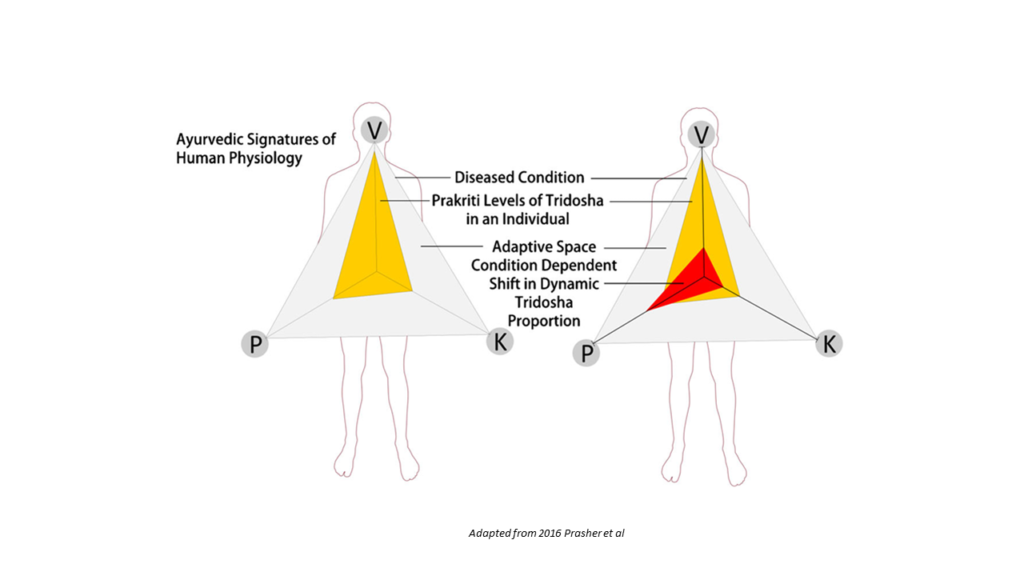
Evidence Based Medicine- Do Evidences Make Sense?

Ayurveda is not considered mainstream medicine today. Many consider it to be dubious. One of the biggest questions raised is “where is the evidence that Ayurveda works?” Modern medicine relies on clinical trials and biostatistics to analyze strength of evidence confirming efficacy and safety of any treatment strategy for a particular disease. In allopathy, one disease can have one medicine that works for most patients. And this can be tested by conducting clinical trials and analyzing the results using biostatistics (I will soon explain that such evidence is flawed when you are treating a patient). However, in case of Ayurveda, treatment of a disease will vary depending on each patient’s unique Prakriti, presenting symptoms, dietary patterns, daily habits and imbalance in the doshas. Ayurveda will not only prescribe a medicine (aushada) but also will advocate on certain behaviors (viharana) and dietary regimes (ahara). These interventions will also be adjusted according to age, mental state (satva, rajas and thamas- three states of mind), the season (climate and other environmental factors), etc. Each individual gets his/her own unique personalized treatment for the same disease. And for the same individual, for the same same disease, treatment strategy may change in Ayurveda depending on time of the year and mental state. (3) (7)
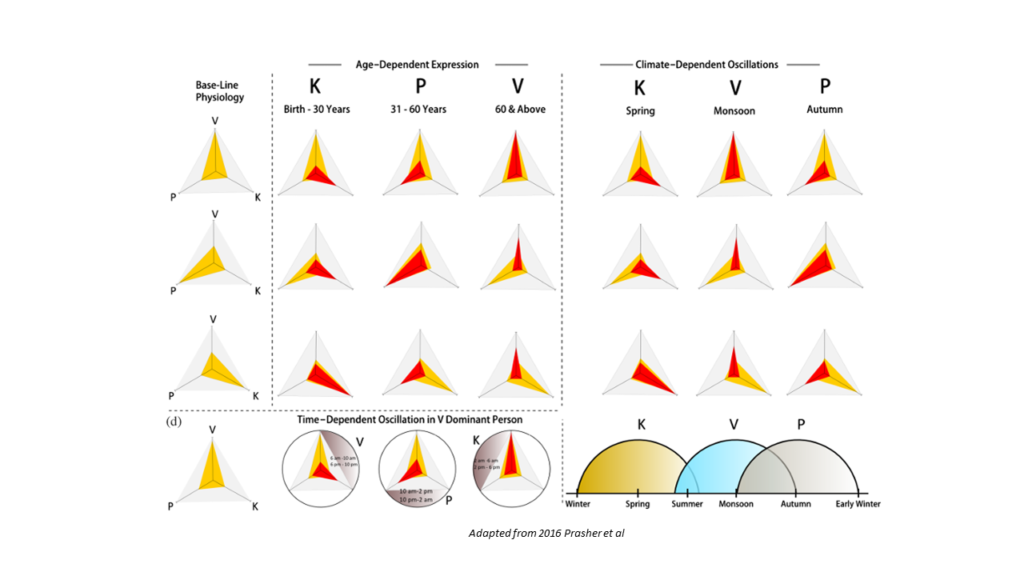
Modern western medicine draws its inferences from clinical trial data analyzed using biostatistics. While it might be factually incorrect to simply say that these interpretations are simply based on law of averages, but they do rely heavily upon theory of probability. In simple terms, all what they can say is what is the chance that a drug will work when used in given population for treating a particular disease.
While clinical trials might say that a medicine is 95% effective, it just means that if that medicine is given in 100 patients, it “might work” in 95 patients. Even in those 95 patients some patients may have extremely good response and some patient may experience below average response. Designing clinical trials itself is not perfect. It based on assumptions which are not quite true. For example, when you have two armed study, the assumption is that patients in both the groups are similar. The ground reality, however, is that no two patients are same- forget about two groups of patients being similar! (4)
But, to be fair, probability does work when you consider large numbers. So, when someone is treating a large set of patients using western medicine, often, the results mimic the data from clinical trials.
Clinical trials and biostatistical methods become quickly impractical when two people with the same condition need entirely different therapies. Consider this non-medical example. Imagine two students with low grades in school. One is not able to sleep properly at night due to stress, while the other one is not at all interested in studying. The approach for improving grades in one student will definitely not work for the other. If we only focused improving sleep and did an experiment to give sleep-enhancing supplements on a population of randomly chosen students without considering interest levels, we will draw absolutely inaccurate conclusions from that trial. In any disease that an individual suffers, there are too many factors and processes unique to that particular individual that modify the disease process for that individual. And these factors cannot be accounted for in any clinical trial.(5) (3)
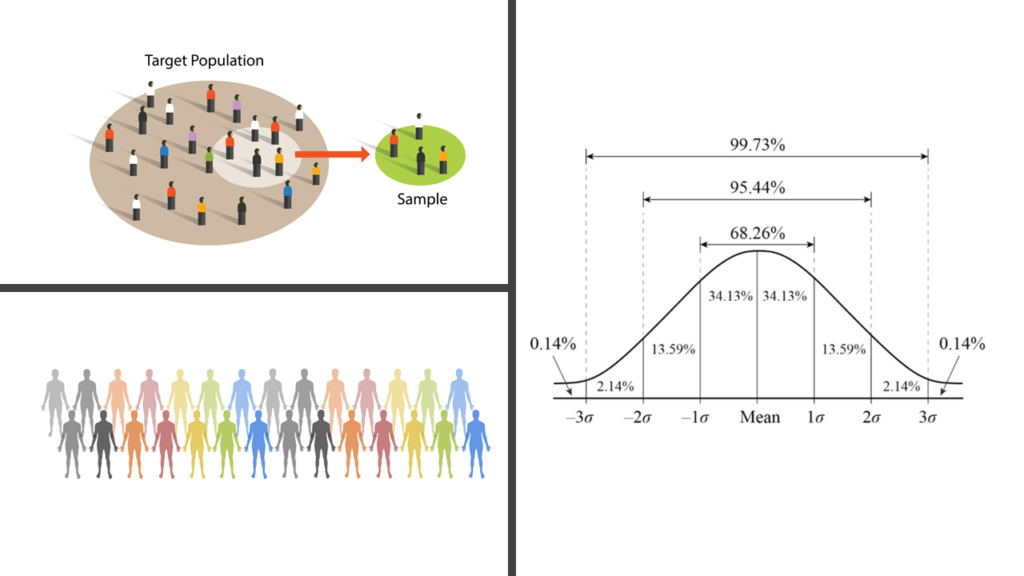
In Ayurveda, treatments are formulated in a holistic and individualized manner after assessing the current state of imbalance in the doshas in the patient. There will be several factors that lead to imbalance in the doshas in an individual and together they are unique to each patient. There is no way you can have a test group and control group matched for all these factors, thus making it logically impossible to conduct clinical trials evaluating Ayurveda. The gold standard double-blind clinical trials just don’t make sense to assess therapies that involve critical lifestyle changes along with herbal formulations. For example, how do we fool an Ayurvedic therapist into prescribing fake meditation at some times and real meditation at other times? And how do you fool the patients and make them “fake” meditate? (5) (3)
In short, the methods of clinical trials and biostatistics cannot be applied to evaluate Ayurveda. It’s like trying to use a microscope to evaluate how planets are moving in the sky.
Towards Personalized Medicine- Where Are We?
Modern medicine is now slowly accepting that each person is unique, and there cannot be a single medicine that works optimally in all patients for treating a disease. For example, it is now known that aspirin does not work similarly in all patients. The inhibitory effect of aspirin on platelets differ according to prakriti of each individual patient. It has been conclusively proven that Vata-Pitta Prakriti individuals show best response to lower doses of aspirin compared to individuals with other prakriti types.(6)
The science of genetics tells us that each person has a set of genes unique to him/her. It is like a signature. Each gene is like a software code, and several such codes work together to make us who we are. With the current advancements in the field of genetics, it now possible to read these genomic signatures for each individual. For a long time, it was believed that one day we will decode functions of every gene and we will know results of various combinations of genes- and from that day onwards we would be able to define which medicine will be the best to treat a disease in a particular person depending on his/her genetic signature.
Unfortunately, it is more complicated than that.
Genotype refers to an individual’s genetic makeup, while phenotype refers to their observable physical traits and characteristics. Phenotype is a result of genes expressing in response to individual’s environment. Today scientists are finding real hard time interpreting genetic signatures because of a phenomenon called genotype-phenotype mismatch. The same genetic variations do not always result in same observable changes in the phenotypes of all individuals. For example, a defect in a gene in X chromosome will cause Fabry Disease in several patients. But the same defect in the same gene might not cause any disease in few other patients. (12) This is extremely intriguing, and directly challenges the whole promise of genomics driven personalized medicine. And the reason for this phenomenon is simple- genes don’t work in a closed system. Our body is an open system. It interacts with its environment. The mood of the person based on his/her interactions with fellow human beings, the age of that person, the room temperature, the fragrance, the sound, the climatic conditions- everything and anything surrounding that person interacts with his/her genes and depending on these interactions few genes over-clock and few genes slow down or stop functioning. This makes it difficult to isolate the effects of individual genetic variations on phenotype. This is a problem that can’t be solved even using AI. We just don’t know enough.
Ayurveda tries solving the same problem of personalization using a remarkably different approach. Rather than trying to decode all the genes and their combinations in an individual (for which one would need extremely costly technologies like SANGER, NGS etc), Ayurveda approaches the problem by simply focusing on phenotypes. As I earlier explained, an individual’s phenotype refers to his/her observable physical traits and characteristics. Ayurveda, in principle, starts by recognizing that each individual is unique. This uniqueness is measured in terms various proportions of doshas in each individual. (7)
As explained earlier, each individual has a unique combination of Vata, Pitta, and Kapha energies. This uniqueness is called Prakriti. In the language of western medicine, we can loosely refer to it as phenotype. Prakriti is believed to be stable throughout an individual’s life with variations happening depending on interactions with others and the environment. (7)
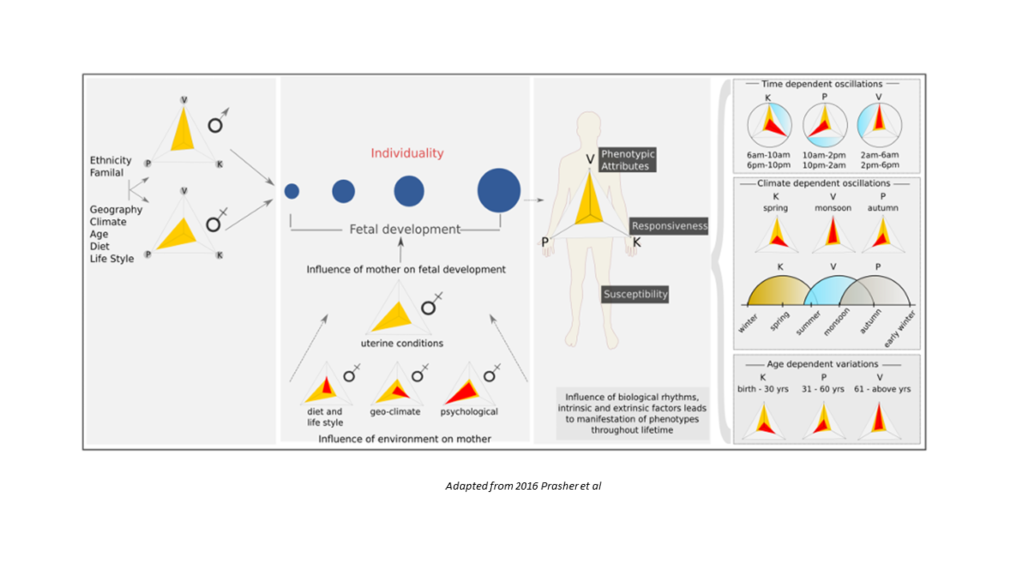
Using the concept of Prakriti, Ayurveda circumvents the challenge of genotype-phenotype mismatch faced by Allopathy. For example, two individuals may have the same genetic variation that increases the risk of a certain disease, but their overall health outcomes may be different due to differences in the interactions between their individual prakriti and environment and lifestyle. One individual may have a strong Vata imbalance due to a stressful lifestyle and lack of sleep, while the other may have a strong Kapha imbalance due to a sedentary lifestyle and poor diet. (7) (8)
Medical Genetics Behind Prakriti and Doshas
In recent years, advances in genomics and bioinformatics have led to a growing interest in understanding the genetic basis of prakriti and its potential implications for personalized medicine. Recent studies have explored the genetic basis of prakriti and its potential implications for personalized medicine.(9) One such study is the “Genome-wide Analysis Correlates Ayurveda Prakriti (GACAP) study” conducted by Periyasamy Govindaraj et al. in 2015. The GACAP study used a genome-wide association study (GWAS) approach to identify genetic variations associated with prakriti in a cohort of 341 individuals. The study identified several genetic variations associated with prakriti, including variations in genes involved in inflammation, metabolism, and neurotransmitter signaling.(10)
Importantly, this study indicated that in any individual, all genes can be grouped into three clusters- each cluster representing one Dosha. This is a remarkable finding, since it simply means that Ayurveda simplifies interpretation of an individual’s genetic make- up without requiring to take any tissue sample or expensive gadgets, while bypassing the fallacies due to genotype-phenotype mismatch.(10)

The study also found that individuals with different prakriti types had different patterns of gene expression and methylation. This again suggests that analyzing prakriti might be more meaningful than analyzing someone’s genes.(10)
Another study conducted by Prasher et al. in 2017 used whole-genome sequencing to explore the genetic basis of prakriti in a cohort of 82 individuals. Similar to the earlier study, this study found that individuals with different prakriti types had different patterns of gene expression and DNA methylation, suggesting that prakriti may be associated with epigenetic modifications that modulate gene expression. Individuals from the three doshas exhibited striking differences with respect to biochemical and hematological parameters and at genome wide expression levels. Biochemical profiles like liver function tests, lipid profiles, and hematological parameters like haemoglobin exhibited differences between the three Prakriti types. (11)
Ayurveda Is Far Beyond Just Treating Any Disease
Ayurveda was not developed in isolation. It was developed to fully harmonize with other Vedic sciences and practices like Yogasana, Pranayama etc. The ancient Indian sciences are deeply interconnected and interdependent. Ayurveda deeply incorporates various aspects of Vedic culture, including the concepts of Gotra and Varna and various others. Gotra is a term used in Vedic culture to denote lineage or ancestry. It refers to the clan or family of an individual, which is determined by their patrilineal ancestry. Varna, on the other hand, is a system of social stratification that divides society into four major categories or varnas based on their occupation, lineage, and temperament.
Ayurveda recognizes the importance of lineage and ancestry in determining an individual’s physical and mental characteristics. The concept of gotra is believed to play a role in determining an individual’s Prakriti. In Ayurveda, it is believed that individuals belonging to the same Gotra are likely to share similar physical and mental characteristics due to their shared ancestry. This understanding of Gotra can help Ayurvedic practitioners in determining an individual’s Prakriti and providing personalized treatment plans based on their unique constitution.
During the Vedic era, the society was classified into four Varnas- Brahmins (priests and scholars), Kshatriyas (warriors and rulers), Vaishyas (merchants and traders), and Shudras (laborers and service providers). The concept of varna played a vital role in Ayurveda, as an individual’s occupation and lifestyle can have an impact on their physical and mental health. According to Ayurveda, an individual’s occupation and lifestyle can influence their Prakriti and susceptibility to certain diseases.
Today, it is quite dangerous socially to talk about Varnas and Gotras. These terms have been tainted and abused. Today, use of these terms would suggest racist and divisive mentality. But, one you understand the science behind these systems, you will realize that they were never developed to create any form social divide. They have simply been misinterpreted by modern media since several decades now using general public’s availability bias and confirmation bias.
This post does not intend to explain the science behind Gotra and Varna systems. Varna system is actually a method of genetic technique called “in-breeding” which is coupled with environment enhancement to super-specialize a phenotype. Gotra system acts as a safety valve to prevent genetic diseases while implementing these genetic “in-breeding” methodologies in masses. I know it won’t make much sense to most readers just by reading previous two sentences. I have a written in detail about the science behind Gotra system HERE. Please do read.
Gotra and Varna are just two of the several Vedic systems that are tied to Ayurveda. There are several others, which are completely out of scope for this post.
Challenges With Ayurveda
It is truly unfortunate that the science of Ayurveda is heading towards an imminent collapse.
Modern medicine is a multi-billion-dollar industry. The amount of revenue generated by western medicine can’t be ignored. That revenue feeds into further investment and growth in western medicine. Discovery of new profitable medicines drives medical research. There is no such level of funding for Ayurveda. Most don’t even consider it as a valid way of treating diseases. Lack of funding and interest is a good recipe to kill any science.
Western allopathy tends to standardize treatment for every disease with few guidance on how treatment paradigms might change with factors such as age or pregnancy etc. It’s easy to learn and implement. Medical negligence can be easily traced back and errors can be identified. In this era where doctors are under constant fear of getting sued/attacked by patients, it is very important to have a way to prove that treatment was in accordance with some documented acceptable standard. And these standards are so rule based that even artificial Intelligence algorithms are now being trained to replace/augment doctors in most cases to mitigate human-led error.
To perfectly learn and use Ayurveda, it takes several decades of dedication and practice with very high levels of intellect and uncompromising ethics. It’s like music. It’s easy to quantify musical notes in terms of frequencies and amplitudes and make rules. But real music is an art that combines emotions and imaginations beyond those rules for musical notes. It is almost impossible to say if an Ayurvedic doctor dispensed the right medicine to a patient, because the treatment would depend on patient’s condition and Dosha imbalance and dietary habits and environmental conditions at the time when the patient came to the doctor. Based on simple pulse examination, a trained Ayurveda expert can diagnose and give accurate medicines. But, there is no way to check if what he did was correct. So, one will have to simply trust the Ayurvedic doctor 100% blindly. It was this exact reason why in ancient times, only few select individuals were allowed to learn and practice Ayurveda.
The other issue is that the ancient Vedic practices which integrate with Ayurveda have today nearly disappeared in oblivion. They were necessary for Ayurveda to be completely effective. The tags of pseudoscience and superstition have killed many of these ancient sciences. In such scenario, the question arises- is Ayurveda still completely relevant?
When I was in high school, I had ZERO maturity to know what I want to do in future. I didn’t even think about Ayurveda vs western medicine when I chose to do MBBS. Today, in India, Ayurveda is usually pursued by students who don’t get MBBS or BDS or engineering (in general). Most start using allopathic methods immediately after they graduate. Several institutes teaching Ayurveda struggle with funding and find it difficult to maintain quality. Pay grade of professors teaching Ayurveda are too low.
Given these facts, how does one trust a doctor practicing Ayurveda? Nevertheless, the fact remains that Ayurveda is a deep science and is comprehensive medical system that holistically treats any disease.
The Way Forward
As seekers of science, we must not give up.
Humanity, as a population, is moving towards a massive health crisis. This is truly evident with sudden explosion of chronic diseases such as diabetes, hypertension, cardiovascular diseases, cancer etc. They are all rising in epidemic proportions. Western medicine has phenomenally increased our knowledge about human biology. We know in depth about millions of molecular pathways and how to manipulate them. Unfortunately, the same approach of exploring the depth leads to myopic approaches for treating diseases. Western medicine is extremely efficient for tackling urgent life- threatening situations but fails miserably to tackle chronic diseases. Approach towards disease and health has to be holistic. Ayurveda uses a simplistic, yet comprehensive and holistic approach considering the fact that all systems and processes are interlinked, and that their interplay is unique in each individual. Ayurveda is not just about curing diseases; it is also a way of life that serves to prevent diseases and promote happiness.
What if there is a better way?
Maybe- there is a way to integrate the “narrow and deep” approach of modern medicine with the holistic approach of Ayurveda. Maybe, we can learn to use modern medicines to bring back lost balance of Doshas in any disease. After all, the herbs used in Ayurveda have pharmacological actions just like any medicine in allopathy. Is it possible to find out laboratory markers to measure each of the doshas and identify Prakriti of each patient? We need to slowly start understanding which molecular pathways are associated predominantly with which doshas. If this approach succeeds then we would be able to identify Dosha imbalance in any patient and start using allopathic medicines optimally along with Ayurvedic methodologies to correct the imbalance.

Science should be science and it should be based on facts and not on what popular media projects; nor should it be based on what is economically profitable. There is a growing segment of young intellectuals in India who are trying to revive this dying science of Ayurveda. I am trying in my own small way towards the same. This article is a small attempt in that direction.
During my research on this topic I came across a brilliant research paper written by Prashar et al. that gives enormous insights into genetic basis of Doshas. The link to that article is HERE. If you get access to the full text, it’s a beautiful reading.
References
2. Sharma H. Ayurveda: Science of life, genetics, and epigenetics. Ayu. 2016;37(2):87-91.
8. Sharma H, Keith Wallace R. Ayurveda and Epigenetics. Medicina (Kaunas). 2020;56(12).
9. Wallace RK. Ayurgenomics and Modern Medicine. Medicina (Kaunas). 2020;56(12).

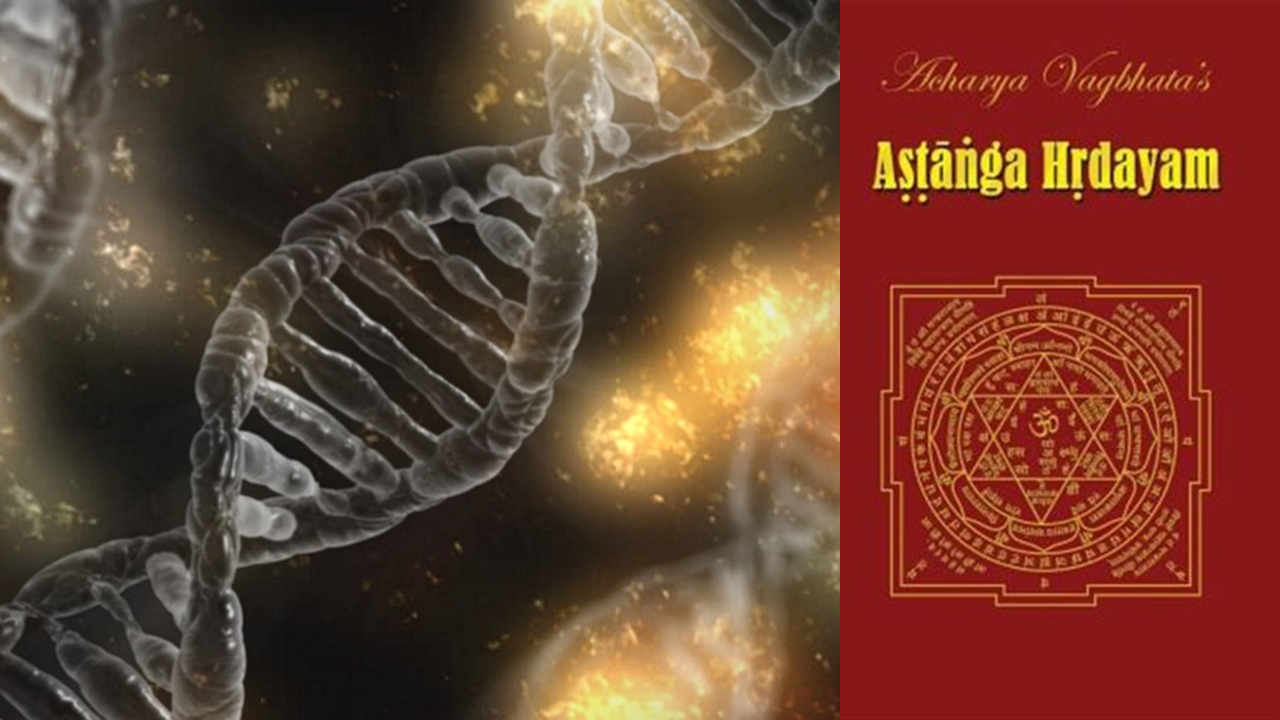




Very nicely articulated. Ayurveda needs to be protected . However to bring it forward and in line with current fundamentals of treatment it will require more evidence to be generated. Govt should fund the ayurvedic research organisations and protect the lineage the way China has been protecting their traditional medicines
I think a lot of movement is happening via new age intellectuals in India. Hope they pave the right way forward.
Good post! We will be linking to this particularly great post on our site. Keep up the great writing
This is my first time pay a quick visit at here and i am really happy to read everthing at one place
I appreciate you sharing this blog post. Thanks Again. Cool.
Nice post. I learn something totally new and challenging on websites
I really like reading through a post that can make men and women think. Also, thank you for allowing me to comment!
I really like reading through a post that can make men and women think. Also, thank you for allowing me to comment!
I appreciate you sharing this blog post. Thanks Again. Cool.
I just like the helpful information you provide in your articles
Good post! We will be linking to this particularly great post on our site. Keep up the great writing
Very well presented. Every quote was awesome and thanks for sharing the content. Keep sharing and keep motivating others.
Hi there to all, for the reason that I am genuinely keen of reading this website’s post to be updated on a regular basis. It carries pleasant stuff.
Awesome! Its genuinely remarkable post, I have got much clear idea regarding from this post
I truly appreciate your technique of writing a blog. I added it to my bookmark site list and will
I truly appreciate your technique of writing a blog. I added it to my bookmark site list and will
I very delighted to find this internet site on bing, just what I was searching for as well saved to fav
Hi there to all, for the reason that I am genuinely keen of reading this website’s post to be updated on a regular basis. It carries pleasant stuff.
very informative articles or reviews at this time.
Good post! We will be linking to this particularly great post on our site. Keep up the great writing
I just like the helpful information you provide in your articles
Very well presented. Every quote was awesome and thanks for sharing the content. Keep sharing and keep motivating others.
I just like the helpful information you provide in your articles
This is my first time pay a quick visit at here and i am really happy to read everthing at one place
I appreciate you sharing this blog post. Thanks Again. Cool.
very informative articles or reviews at this time.
Pretty! This has been a really wonderful post. Many thanks for providing these details.
Very well presented. Every quote was awesome and thanks for sharing the content. Keep sharing and keep motivating others.
I like the efforts you have put in this, regards for all the great content.
Brilliant post, I couldn’t agree more!
This is really interesting, You’re a very skilled blogger. I’ve joined your feed and look forward to seeking more of your magnificent post. Also, I’ve shared your site in my social networks!
I just like the helpful information you provide in your articles
Nice post. I learn something totally new and challenging on websites
This is really interesting, You’re a very skilled blogger. I’ve joined your feed and look forward to seeking more of your magnificent post. Also, I’ve shared your site in my social networks!
I am utterly amazed by the sheer brilliance of this website. From the moment I stumbled upon it, I was captivated by the depth and value of its contents. Each post is a masterpiece of knowledge, meticulously crafted and expertly presented. I am thoroughly delighted to have found a digital haven where I can indulge in learning, introspection, and the broadening of my perspectives on a myriad of topics. The administrator of this site deserves every accolade for their unwavering dedication, tireless efforts, and the remarkable ability to deliver an enriching experience to their readers. Undoubtedly, this website is bound for fame and admiration, owing to its outstanding quality and invaluable contribution to the world of knowledge.
This is really interesting, You’re a very skilled blogger. I’ve joined your feed and look forward to seeking more of your magnificent post. Also, I’ve shared your site in my social networks!
I appreciate you sharing this blog post. Thanks Again. Cool.
You’ve got a knack for simplifying complex topics, bravo!
Great information shared.. really enjoyed reading this post thank you author for sharing this post .. appreciated
This website has become a beacon of intellectual enlightenment in a sea of information overload. The administrator’s dedication to delivering exceptional content is evident in every aspect of this platform. Each post is meticulously researched, offering readers a valuable source of knowledge that is both reliable and engaging. The administrator’s ability to present complex ideas in a clear and accessible manner is truly commendable, making the content accessible to readers of all backgrounds. This website has become my go-to resource for reliable information and a source of inspiration for my own intellectual pursuits. I am immensely grateful for the administrator’s unwavering commitment to providing a platform that nourishes the mind, stimulates curiosity, and encourages the pursuit of knowledge.
Awesome! Its genuinely remarkable post, I have got much clear idea regarding from this post
very informative articles or reviews at this time.
Great information shared.. really enjoyed reading this post thank you author for sharing this post .. appreciated
I’m often to blogging and i really appreciate your content. The article has actually peaks my interest. I’m going to bookmark your web site and maintain checking for brand spanking new information.
I very delighted to find this internet site on bing, just what I was searching for as well saved to fav
I just like the helpful information you provide in your articles
Nice post. I learn something totally new and challenging on websites
Allow me to express my profound gratitude to the administrator of this site for providing us with an intellectual oasis amidst the vast ocean of online information. Each post is a treasure trove filled with wisdom and understanding. I admire how the author approaches topics from a unique standpoint, offering fresh and thought-provoking insights that challenge my preconceived notions. Furthermore, the meticulous structuring of each article and the presentation of well-reasoned arguments supported by reliable evidence is a testament to the administrator’s intellectual rigor and attention to detail. I eagerly anticipate delving deeper into the riches of knowledge this site has to offer and continuing to nourish my mind with its invaluable resources.
This is really interesting, You’re a very skilled blogger. I’ve joined your feed and look forward to seeking more of your magnificent post. Also, I’ve shared your site in my social networks!
Nice post. I learn something totally new and challenging on websites
I appreciate you sharing this blog post. Thanks Again. Cool.
You’re so awesome! I don’t believe I have read a single thing like that before. So great to find someone with some original thoughts on this topic. Really.. thank you for starting this up. This website is something that is needed on the internet, someone with a little originality!
I really like reading through a post that can make men and women think. Also, thank you for allowing me to comment!
The writing on this site is top-notch. It’s a pleasure to read every word.
Your blog has helped me overcome numerous challenges in my [topic]-related endeavors. I appreciate the practical advice and the encouragement you provide. Thank you for making a difference in my life.
Love your perspective, such a refreshing read!
I like the efforts you have put in this, regards for all the great content.
For the reason that the admin of this site is working, no uncertainty very quickly it will be renowned, due to its quality contents.
Your writing has a way of touching hearts and stirring emotions. I appreciate the rawness and authenticity you bring to your articles. Thank you for sharing your stories with us.
This website has become my intellectual sanctuary, a place where I can escape the noise of the digital world and indulge in a haven of knowledge. The administrator’s dedication to providing comprehensive, well-researched content is truly remarkable. Each article is a masterpiece, crafted with precision and delivered with eloquence. I find myself constantly in awe of the administrator’s ability to tackle complex subjects and distill them into digestible pieces of information. The depth of insight and the clarity of thought presented on this platform have opened my mind to new perspectives and expanded my understanding of the world. This website is not just a source of information; it is a catalyst for personal growth and intellectual exploration. I am indebted to the administrator for their commitment to creating an invaluable resource that enriches the lives of its readers.
I do not even understand how I ended up here, but I assumed this publish used to be great
This is my first time pay a quick visit at here and i am really happy to read everthing at one place
There is definately a lot to find out about this subject. I like all the points you made
Awesome! Its genuinely remarkable post, I have got much clear idea regarding from this post
This is my first time pay a quick visit at here and i am really happy to read everthing at one place
I am truly thankful to the owner of this web site who has shared this fantastic piece of writing at at this place.
This is really interesting, You’re a very skilled blogger. I’ve joined your feed and look forward to seeking more of your magnificent post. Also, I’ve shared your site in my social networks!
Awesome! Its genuinely remarkable post, I have got much clear idea regarding from this post
This was beautiful Admin. Thank you for your reflections.
Wow, this is exactly what I needed!
Great information shared.. really enjoyed reading this post thank you author for sharing this post .. appreciated
Nice post. I learn something totally new and challenging on websites
I appreciate you sharing this blog post. Thanks Again. Cool.
I appreciate the author’s dedication to providing accurate and up-to-date content. It’s commendable.
I am truly thankful to the owner of this web site who has shared this fantastic piece of writing at at this place.
This is really interesting, You’re a very skilled blogger. I’ve joined your feed and look forward to seeking more of your magnificent post. Also, I’ve shared your site in my social networks!
Hi there to all, for the reason that I am genuinely keen of reading this website’s post to be updated on a regular basis. It carries pleasant stuff.
Awesome! Its genuinely remarkable post, I have got much clear idea regarding from this post
This is really interesting, You’re a very skilled blogger. I’ve joined your feed and look forward to seeking more of your magnificent post. Also, I’ve shared your site in my social networks!
I am truly thankful to the owner of this web site who has shared this fantastic piece of writing at at this place.
Hi there to all, for the reason that I am genuinely keen of reading this website’s post to be updated on a regular basis. It carries pleasant stuff.
You’re so awesome! I don’t believe I have read a single thing like that before. So great to find someone with some original thoughts on this topic. Really.. thank you for starting this up. This website is something that is needed on the internet, someone with a little originality!
This was beautiful Admin. Thank you for your reflections.
There is definately a lot to find out about this subject. I like all the points you made
This was beautiful Admin. Thank you for your reflections.
Very well presented. Every quote was awesome and thanks for sharing the content. Keep sharing and keep motivating others.
I just like the helpful information you provide in your articles
For the reason that the admin of this site is working, no uncertainty very quickly it will be renowned, due to its quality contents.
This was beautiful Admin. Thank you for your reflections.
I think this is a real great article.Really thank you! Fantastic.
Great information shared.. really enjoyed reading this post thank you author for sharing this post .. appreciated
I read this article completely on the topic of the comparison of most up-to-date and earlier technologies, it’s awesomearticle.Also visit my blog – hatched seeds
Great information shared.. really enjoyed reading this post thank you author for sharing this post .. appreciated
Awesome! Its genuinely remarkable post, I have got much clear idea regarding from this post
This was beautiful Admin. Thank you for your reflections.
I really like reading through a post that can make men and women think. Also, thank you for allowing me to comment!
For the reason that the admin of this site is working, no uncertainty very quickly it will be renowned, due to its quality contents.
Nice post. I learn something totally new and challenging on websites
I’m often to blogging and i really appreciate your content. The article has actually peaks my interest. I’m going to bookmark your web site and maintain checking for brand spanking new information.
Hi there to all, for the reason that I am genuinely keen of reading this website’s post to be updated on a regular basis. It carries pleasant stuff.
I just like the helpful information you provide in your articles about Bodrum full teeth restoration.
I do not even understand how I ended up here, but I assumed this publish used to be great
This is my first time pay a quick visit at here and i am really happy to read everthing at one place
I do not even understand how I ended up here, but I assumed this publish used to be great
I like the efforts you have put in this, regards for all the great content.
Very well presented, every quote was awesome about Bodrum dental implants and thanks for sharing the content, keep sharing and keep motivating others.
Awesome! Its genuinely remarkable post, I have got much clear idea regarding from this post
I really like reading through a post that can make men and women think. Also, thank you for allowing me to comment!
naturally like your web site however you need to take a look at the spelling on several of your posts. A number of them are rife with spelling problems and I find it very bothersome to tell the truth on the other hand I will surely come again again.
I very delighted to find this internet site on bing, just what I was searching for as well saved to fav
very informative articles or reviews at this time.
Awesome! Its genuinely remarkable post, I have got much clear idea regarding from this post
I like the efforts you have put in this, regards for all the great content.
Successful sharing. Thanks for your hard work.
Good post! We will be linking to this particularly great post on our site. Keep up the great writing
Awesome! Its genuinely remarkable post, I have got much clear idea regarding from this post
Harness the power of your opinions and convert them into real cash with surveys.
I do not even understand how I ended up here, but I assumed this publish used to be great
Mind blown! Your expertise shines through this article.
Awesome! Its genuinely remarkable post, I have got much clear idea regarding from this post
I am truly thankful to the owner of this web site who has shared this fantastic piece of writing at at this place.
Good post! We will be linking to this particularly great post on our site. Keep up the great writing
I appreciate you sharing this blog post. Thanks Again. Cool.
I am truly thankful to the owner of this web site who has shared this fantastic piece of writing at at this place.
I am truly thankful to the owner of this web site who has shared this fantastic piece of writing at at this place.
Pretty! This has been a really wonderful post. Many thanks for providing these details.
This was beautiful Admin. Thank you for your reflections.
Good post! We will be linking to this particularly great post on our site. Keep up the great writing
Nice post. I learn something totally new and challenging on websites
Nice post. I learn something totally new and challenging on websites
naturally like your web site however you need to take a look at the spelling on several of your posts. A number of them are rife with spelling problems and I find it very bothersome to tell the truth on the other hand I will surely come again again.
I very delighted to find this internet site on bing, just what I was searching for as well saved to fav
This was beautiful Admin. Thank you for your reflections.
Awesome! Its genuinely remarkable post, I have got much clear idea regarding from this post
This is my first time pay a quick visit at here and i am really happy to read everthing at one place
I truly appreciate your technique of writing a blog. I added it to my bookmark site list and will
I like the efforts you have put in this, regards for all the great content.
I like the efforts you have put in this, regards for all the great content.
I am truly thankful to the owner of this web site who has shared this fantastic piece of writing at at this place.
I like the efforts you have put in this, regards for all the great content.
I very delighted to find this internet site on bing, just what I was searching for as well saved to fav
This is my first time pay a quick visit at here and i am really happy to read everthing at one place
I’m often to blogging and i really appreciate your content. The article has actually peaks my interest. I’m going to bookmark your web site and maintain checking for brand spanking new information.
Hi there to all, for the reason that I am genuinely keen of reading this website’s post to be updated on a regular basis. It carries pleasant stuff.
You’re so awesome! I don’t believe I have read a single thing like that before. So great to find someone with some original thoughts on this topic. Really.. thank you for starting this up. This website is something that is needed on the internet, someone with a little originality!
Fantastic site. Lots of helpful information here. I am sending it to some friends ans additionally sharing in delicious. And of course, thanks for your effort!
Good post! We will be linking to this particularly great post on our site. Keep up the great writing
I am truly thankful to the owner of this web site who has shared this fantastic piece of writing at at this place.
Great information shared.. really enjoyed reading this post thank you author for sharing this post .. appreciated
Great information shared.. really enjoyed reading this post thank you author for sharing this post .. appreciated
I like the efforts you have put in this, regards for all the great content.
There is definately a lot to find out about this subject. I like all the points you made
Very well presented. Every quote was awesome and thanks for sharing the content. Keep sharing and keep motivating others.
I appreciate you sharing this blog post. Thanks Again. Cool.
Very well presented. Every quote was awesome and thanks for sharing the content. Keep sharing and keep motivating others.
I really like reading through a post that can make men and women think. Also, thank you for allowing me to comment!
Very well presented. Every quote was awesome and thanks for sharing the content. Keep sharing and keep motivating others.
For the reason that the admin of this site is working, no uncertainty very quickly it will be renowned, due to its quality contents.
very informative articles or reviews at this time.
Pretty! This has been a really wonderful post. Many thanks for providing these details.
This is really interesting, You’re a very skilled blogger. I’ve joined your feed and look forward to seeking more of your magnificent post. Also, I’ve shared your site in my social networks!
I like the efforts you have put in this, regards for all the great content.
Pretty! This has been a really wonderful post. Many thanks for providing these details.
For the reason that the admin of this site is working, no uncertainty very quickly it will be renowned, due to its quality contents.
I like the efforts you have put in this, regards for all the great content.
I am truly thankful to the owner of this web site who has shared this fantastic piece of writing at at this place.
very informative articles or reviews at this time.
I am truly thankful to the owner of this web site who has shared this fantastic piece of writing at at this place.
There is definately a lot to find out about this subject. I like all the points you made
I like the efforts you have put in this, regards for all the great content.
I truly appreciate your technique of writing a blog. I added it to my bookmark site list and will
I really like reading through a post that can make men and women think. Also, thank you for allowing me to comment!
I like the efforts you have put in this, regards for all the great content.
You’re so awesome! I don’t believe I have read a single thing like that before. So great to find someone with some original thoughts on this topic. Really.. thank you for starting this up. This website is something that is needed on the internet, someone with a little originality!
Awesome! Its genuinely remarkable post, I have got much clear idea regarding from this post
Hi there to all, for the reason that I am genuinely keen of reading this website’s post to be updated on a regular basis. It carries pleasant stuff.
Hi there to all, for the reason that I am genuinely keen of reading this website’s post about Turkey dental clinic to be updated on a regular basis, it carries pleasant stuff.
This was beautiful Admin. Thank you for your reflections.
Good post! We will be linking to this particularly great post on our site. Keep up the great writing
You’re so awesome! I don’t believe I have read a single thing like that before. So great to find someone with some original thoughts on this topic. Really.. thank you for starting this up. This website is something that is needed on the internet, someone with a little originality!
I very delighted to find this internet site on bing, just what I was searching for as well saved to fav
This was beautiful Admin. Thank you for your reflections.
I truly appreciate your technique of writing a blog. I added it to my bookmark site list and will
I just like the helpful information you provide in your articles
I’m often to blogging and i really appreciate your content. The article has actually peaks my interest. I’m going to bookmark your web site and maintain checking for brand spanking new information.
This was beautiful Admin. Thank you for your reflections.
I like the efforts you have put in this, regards for all the great content.
For the reason that the admin of this site is working, no uncertainty very quickly it will be renowned, due to its quality contents.
This was beautiful Admin. Thank you for your reflections.
Nice post. I learn something totally new and challenging on websites
I truly appreciate your technique of writing a blog. I added it to my bookmark site list and will
This is my first time pay a quick visit at here and i am really happy to read everthing at one place
This is really interesting, You’re a very skilled blogger. I’ve joined your feed and look forward to seeking more of your magnificent post. Also, I’ve shared your site in my social networks!
You’re so awesome! I don’t believe I have read a single thing like that before. So great to find someone with some original thoughts on this topic. Really.. thank you for starting this up. This website is something that is needed on the internet, someone with a little originality!
Awesome! Its genuinely remarkable post, I have got much clear idea regarding from this post
Pretty! This has been a really wonderful post. Many thanks for providing these details.
Great information shared.. really enjoyed reading this post thank you author for sharing this post .. appreciated
Pretty! This has been a really wonderful post. Many thanks for providing these details.
Hi there to all, for the reason that I am genuinely keen of reading this website’s post to be updated on a regular basis. It carries pleasant stuff.
This is really interesting, You’re a very skilled blogger. I’ve joined your feed and look forward to seeking more of your magnificent post. Also, I’ve shared your site in my social networks!
This is my first time pay a quick visit at here and i am really happy to read everthing at one place
This is really interesting, You’re a very skilled blogger. I’ve joined your feed and look forward to seeking more of your magnificent post. Also, I’ve shared your site in my social networks!
I just like the helpful information you provide in your articles
I truly appreciate your technique of writing a blog. I added it to my bookmark site list and will
This is my first time pay a quick visit at here and i am really happy to read everthing at one place
Great information shared.. really enjoyed reading this post thank you author for sharing this post .. appreciated
I truly appreciate your technique of writing a blog. I added it to my bookmark site list and will
For the reason that the admin of this site is working, no uncertainty very quickly it will be renowned, due to its quality contents.
very informative articles or reviews at this time.
I like the efforts you have put in this, regards for all the great content.
Hey there, You have done a fantastic job. I will certainly digg it and personally recommend to my friends. I’m confident they’ll be benefited from this site.
I truly appreciate your technique of writing a blog. I added it to my bookmark site list and will
Nice post. I learn something totally new and challenging on websites
I just like the helpful information you provide in your articles
Very well presented. Every quote was awesome and thanks for sharing the content. Keep sharing and keep motivating others.
Aw, this became an extremely nice post. In idea I must place in writing similar to this additionally – taking time and actual effort to have a really good article… but exactly what do I say… I procrastinate alot through no indicates find a way to get something carried out.
I very delighted to find this internet site on bing, just what I was searching for as well saved to fav
Pretty! This has been a really wonderful post. Many thanks for providing these details.
Very well presented. Every quote was awesome and thanks for sharing the content. Keep sharing and keep motivating others.
Awesome! Its genuinely remarkable post, I have got much clear idea regarding from this post
This was beautiful Admin. Thank you for your reflections.
I like the efforts you have put in this, regards for all the great content.
I very delighted to find this internet site on bing, just what I was searching for as well saved to fav
I’m often to blogging and i really appreciate your content. The article has actually peaks my interest. I’m going to bookmark your web site and maintain checking for brand spanking new information.
This is my first time pay a quick visit at here and i am really happy to read everthing at one place moviesbox.net
I truly appreciate your technique of writing a blog. I added it to my bookmark site list and will moviesbox.net
I’m often to blogging and i really appreciate your content. The article has actually peaks my interest. I’m going to bookmark your web site and maintain checking for brand spanking new information.
Very well presented. Every quote was awesome and thanks for sharing the content. Keep sharing and keep motivating others.
I really like reading through a post that can make men and women think. Also, thank you for allowing me to comment!
You’re so awesome! I don’t believe I have read a single thing like that before. So great to find someone with some original thoughts on this topic. Really.. thank you for starting this up. This website is something that is needed on the internet, someone with a little originality!
I really like reading through a post that can make men and women think. Also, thank you for allowing me to comment!
I very delighted to find this internet site on bing, just what I was searching for as well saved to fav
Good morning! I wish I was there to snooze the alarm clock with you.
Good post! We will be linking to this particularly great post on our site. Keep up the great writing
I appreciate you sharing this blog post. Thanks Again. Cool.
Great information shared.. really enjoyed reading this post thank you author for sharing this post .. appreciated
You’re so awesome! I don’t believe I have read a single thing like that before. So great to find someone with some original thoughts on this topic. Really.. thank you for starting this up. This website is something that is needed on the internet, someone with a little originality!
great articles, and also, if you want free windows or mac software, you can download from my website.
The site’s admin is working, undoubtedly leading to its future renown due to its quality content.
naturally like your web site however you need to take a look at the spelling on several of your posts. A number of them are rife with spelling problems and I find it very bothersome to tell the truth on the other hand I will surely come again again.
I am truly thankful to the owner of this web site who has shared this fantastic piece of writing at at this place.
naturally like your web site however you need to take a look at the spelling on several of your posts. A number of them are rife with spelling problems and I find it very bothersome to tell the truth on the other hand I will surely come again again.
I found the article very impressive and thought-provoking.
I truly appreciate your technique of writing a blog. I added it to my bookmark site list and will
Wonderful web site. Lots of useful info here. I’m sending it to a few friends ans additionally sharing in delicious. And obviously, thanks to your effort!
I like the efforts you have put in this, regards for all the great content.
I do not even understand how I ended up here, but I assumed this publish used to be great
I just could not depart your web site prior to suggesting that I really loved the usual info an individual supply in your visitors? Is gonna be back regularly to check up on new posts.
I truly appreciate your technique of writing a blog. I added it to my bookmark site list and will
For the reason that the admin of this site is working, no uncertainty very quickly it will be renowned, due to its quality contents.
very informative articles or reviews at this time.
naturally like your web site however you need to take a look at the spelling on several of your posts. A number of them are rife with spelling problems and I find it very bothersome to tell the truth on the other hand I will surely come again again.
naturally like your web site however you need to take a look at the spelling on several of your posts. A number of them are rife with spelling problems and I find it very bothersome to tell the truth on the other hand I will surely come again again.
You’re so awesome! I don’t believe I have read a single thing like that before. So great to find someone with some original thoughts on this topic. Really.. thank you for starting this up. This website is something that is needed on the internet, someone with a little originality!
I’m often to blogging and i really appreciate your content. The article has actually peaks my interest. I’m going to bookmark your web site and maintain checking for brand spanking new information.
I just like the helpful information you provide in your articles
Your words of encouragement are like a virtual hug! In a world that can be challenging, your supportive messages bring comfort and warmth. Grateful to have you in my online circle.
Great information shared.. really enjoyed reading this post thank you author for sharing this post .. appreciated
Nice post. I learn something totally new and challenging on websites
Best article, wonderfull..
I really like reading through a post that can make men and women think. Also, thank you for allowing me to comment!
I just like the helpful information you provide in your articles
You’re so awesome! I don’t believe I have read a single thing like that before. So great to find someone with some original thoughts on this topic. Really.. thank you for starting this up. This website is something that is needed on the internet, someone with a little originality!
very informative articles or reviews at this time.
There is definately a lot to find out about this subject. I like all the points you made
Thank you so much
I do not even understand how I ended up here, but I assumed this publish used to be great
I just like the helpful information you provide in your articles
This is my first time pay a quick visit at here and i am really happy to read everthing at one place
Good post! We will be linking to this particularly great post on our site. Keep up the great writing
You’re so awesome! I don’t believe I have read a single thing like that before. So great to find someone with some original thoughts on this topic. Really.. thank you for starting this up. This website is something that is needed on the internet, someone with a little originality!
Great information shared.. really enjoyed reading this post thank you author for sharing this post .. appreciated
I very delighted to find this internet site on bing, just what I was searching for as well saved to fav
Very well presented. Every quote was awesome and thanks for sharing the content. Keep sharing and keep motivating others.
Very well presented. Every quote was awesome and thanks for sharing the content. Keep sharing and keep motivating others.
I am truly thankful to the owner of this web site who has shared this fantastic piece of writing at at this place.
Hi there to all, for the reason that I am genuinely keen of reading this website’s post to be updated on a regular basis. It carries pleasant stuff.
Hi there to all, for the reason that I am genuinely keen of reading this website’s post to be updated on a regular basis. It carries pleasant stuff.
I truly appreciate your technique of writing a blog. I added it to my bookmark site list and will
very informative articles or reviews at this time.